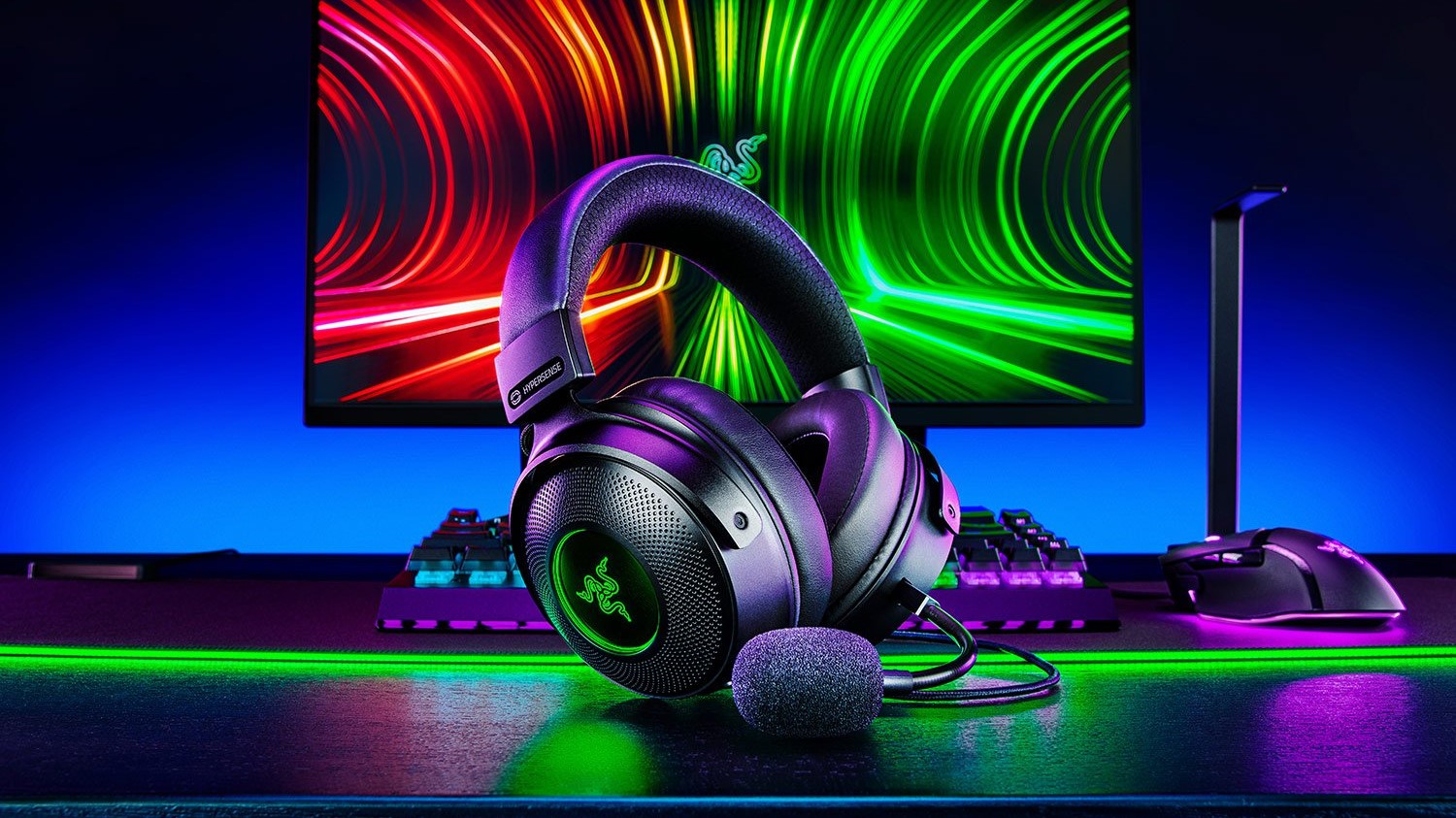Our Verdict
A few niggles keep Razer's Kraven V3 Hypersense from achieving perfection, but it makes a strong argument for more haptic-powered headsets.
- Unique bass-driven haptic feedback
- Detailed audio
- Adjustable EQ levels with Razer Central
- Requires tinkering
- Surround sound Windows-only
When I was small and curious, I’d often stick the side of my head up against my dad’s large hi-fi speakers. This is, admittedly, a silly thing to do with developing ears, but the fond memories of my musical youth are partially why I love the sensation of bassy vibrations at gigs. Of course, shuddering volume levels are usually reserved for high wattage speakers, so you can imagine my surprise to find Razer’s Kraken V3 Hypersense manages to emulate the experience. Better still, the new headset brings that same audio physicality to the realm of gaming, and its implementation is almost perfect.
Before we dive into Razer’s rumbly tech, let’s talk about the specific version of the Kraken that houses it. Just like its gaming audio counterparts, the Kraken Hypersense comprises plastic, metal, fabric, and leatherette, which contribute to both its premium and comfort factor. While there’s more going on inside this rendition of the Kraken, it’s still remarkably lightweight, something it’s able to maintain alongside rigidity.
I’m also a huge fan of the Hypersense’s cups and headband, as Razer has stuck to its usual fabric and leatherette hybrid setup. Sure, leatherette arguably looks more stylish, but it doesn’t age well when resting against human skin for lengthy gaming sessions. It’s worth noting that I’m also sensitive to certain materials, especially if they’re anything less than soft, so this headset gains some additional Brownie points.
Naturally, the V3 Hypersense comes with RGB-clad cups, and you can wield them within Razer’s Synapse software. Each jewel logo features ring and logo illumination, resulting in lighting that’s subtle but bright. Put it this way, if you’re a streamer, your chat will likely ask about this headset’s light show, as it feels distinctly different from the rest of the Kraken range.
Being a headset, the Hypersense also comes armed with a detachable mic, boasting clarity and noise reduction. It won’t force the best gaming microphone into retirement, but for voice calls, game chat, and everything in between, it’s perfectly serviceable. Although, in honesty, the mic’s bulbous pop filter looks a bit too much like a John Madden cosplay for my tastes.
| Razer Kraken V3 Hypersense | Logitech’s G733 | EPOS H6Pro | |
|---|---|---|---|
| Frequency response | 20Hz – 20kHz | 20Hz – 20kHz | 10Hz – 30kHz |
| Connectivity | USB | 3.5mm | USB | 3.5mm wired |
| Mic response | 100Hz – 10kHz | 100Hz – 10kHz | 10Hz – 10kHz |
| Weight | 344g | 278g | 278g |
| Price | $129 / £129 | $127 / £129 | $179 / £149 |
A volume wheel, mic mute button, and a Hypersense mode button also occupy space on the back of the Kraken V3’s cups. Both the volume wheel and the mic mute button are easy to locate while wearing, which prevents any frustrating fumbles. The volume controls also come with a commendable level of accuracy, with each movement translating to increments and deductions of two. The mute button is also pleasing to press, as Razer’s use of a toggle switch provides a level of reassurance when knowing if you’re actually muted.
Aesthetics and headset staples aside, the Hypersense’s real selling point is its unique haptic feedback system that dwells within the cups. Simply put, this set of cans translates lower frequencies into tactile vibrations, meaning you’ll feel every explosion, gunshot, and smack heading your way in FPS games. In reality, the sensation feels more akin to a subwoofer than having two Dualshock controllers strapped to your head, which works in the V3 Hypersense’s favour.
The new V3’s Hypersense functionality comes with three adjustable settings, with each increasing vibration intensity. Throughout testing, I found that the lowest and middle settings yield the best results, especially during hectic multiplayer matches. While subtle vibrations are useful when it comes to detecting the direction of footsteps and gunfire, Razer’s haptic feedback serves as a distraction when cranked up full, and it muddies the headset’s 7.1 spatial audio.
Speaking of 7.1 audio, the V3 Hypersense’s virtual surround sound capabilities are on point, especially when balanced with haptics. In a way, Razer’s novel headset has trained my ears to listen out for subtle first-person game audio, something that has made all the difference when playing Halo Infinite online. Admittedly, the likes of EPOS’ H6Pro also features similar spatial audio abilities, but when paired with the sensation of rumbling bass, the V3 Hypersense blows comparative headsets out of the water.
 Buy now on Amazon
Buy now on Amazon
The Kraken V3 Hypersense also links up with Razer Central, meaning you can play about with the headset’s settings using Synapse. The suite provides access to a variety of options and features, like an EQ, THQ and Spatial 7.1 settings, and Chroma RGB bells and whistles. Disappointingly, the software doesn’t include any additional options to adjust haptic feedback, as the appropriate section replicates the button’s low, medium, and high modes.
That said, by tweaking the bass frequencies in the headset’s equaliser settings, you can change how the haptics respond to audio. Admittedly, it can be hard to determine where the roaring explosions in a game land on the EQ scale, but if you’re willing to experiment, you could mix your game audio in a way that reserves haptics for specific sounds. If a future update could automate this process with specific Hypersense settings, it could enhance the feature’s usability tenfold, but as things currently stand, the device’s three options aren’t as accommodating as I’d like.
In terms of versatility, the Kraken V3 Hypersense is actually compatible with consoles, so it could prove to be a comprehensive audio solution. However, unlike the Razer Kraken Tournament Edition, the headset uses a single USB connection, rather than a detachable 3.5mm DAC, meaning alternative amplifiers and adapters aren’t an option. This is probably linked to the device’s haptic innards, but for $129.99, it’d be nice to reap the benefits of both connections.
Ultimately, the Kraken V3 Hypersense is more than a vibrating novelty; it’s a testament to haptic feedback accessories. While providing a wider array of settings would bolster the overall experience, the V3 Hypersense facilitates a fascinating sense of audio physicality, making it one of the best gaming headsets on the market in terms of immersion. Of course, Razer’s staple RGB lighting and build quality are also a huge selling point, so if you’re considering picking up a set of Kraken cans, you might want to consider investing in this haptic heavy hitter.

